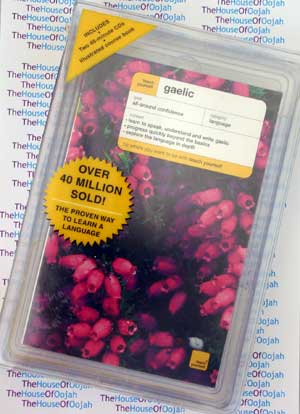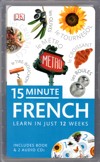Teach Yourself Gaelic - 2 Audio CDs and Book - Learn to speak Gaelic

Teach Yourself GaelicView other Gaelic Language Learning Audio click here |
 |
Teach Yourself Gaelic - 2 Audio CDs and Book CDBrand New (Book and 2 CDs): Learning Gaelic as easy as 1-2-3 With this book, Gaelic is attainable for any beginning student. You can use Teach Yourself Gaelic Complete Course at your own pace or as a supplement to formal courses. This complete course is based on the very latest learning methods and designed to be enjoyable and user-friendly. Prepared by experts in the language, Teach Yourself Gaelic begins with the basics and gradually promotes you to a level of smooth and confident communication, including: * Up-to-date, graded interactive dialogues Package includes two 60-minute CDs and a book. About the Authors
Iain Taylor is an experienced teacher and scriptwriter. About the Gaelic Language
Classical Gaelic was used as a literary language in Ireland until the 17th century and in Scotland until the 18th century. Later orthographic divergence is the result of more recent orthographic reforms resulting in standardised pluricentric diasystems. The 1767 New Testament historically set the standard for Scottish Gaelic. Around the time of World War II, Irish spelling was reformed and the Official Standard or Caighdeán Oifigiúil introduced. Further reform in 1957 eliminated some of the silent letters which are still used in Scottish Gaelic. The 1981 Scottish Examinations Board recommendations for Scottish Gaelic, the Gaelic Orthographic Conventions, were adopted by most publishers and agencies, although they remain controversial among some academics, most notably Ronald Black. The modern Scottish Gaelic alphabet has 18 letters: A, B, C, D, E, F, G, H, I, L, M, N, O, P, R, S, T, U. The letter h, now mostly used to indicate lenition of a consonant, was in general not used in the oldest orthography, as lenition was instead indicated with a dot over the lenited consonant. The letters of the alphabet were traditionally named after trees (see Scottish Gaelic alphabet), but this custom has fallen out of use. The quality of consonants is indicated in writing by the vowels surrounding them. So-called "slender" consonants are palatalised while "broad" consonants are velarised. The vowels e and i are classified as slender, and a, o, and u as broad. The spelling rule known as caol ri caol agus leathann ri leathann ("slender to slender and broad to broad") requires that a word-medial consonant or consonant group followed by a written i or e be also preceded by an i or e; and similarly if followed by a, o or u be also preceded by an a, o, or u. Consonant quality (palatalised or non-palatalised) is then indicated by the vowels written adjacent to a consonant, and the spelling rule gives the benefit of removing possible uncertainty about consonant quality at the expense of adding additional purely graphic vowels that may not be pronounced. In changes promoted by the Scottish Examination Board from 1976 onwards, certain modifications were made to this rule. For example, the suffix of the past participle is always spelled -te, even after a broad consonant, as in togte "raised" (rather than the traditional togta). Where pairs of vowels occur in writing, it is sometimes unclear which vowel is to be pronounced and which vowel has been introduced to satisfy this spelling rule. Unstressed vowels omitted in speech can be omitted in informal writing. For example: Tha mi an dòchas. ("I hope.") > Tha mi 'n dòchas. Once Gaelic orthographic rules have been learned, the pronunciation of the written language can be seen to be quite predictable. However learners must be careful not to try to apply English sound-to-letter correspondences to written Gaelic, otherwise mispronunciations will result. Gaelic personal names such as Seònaid are especially likely to be mispronounced by English speakers. English orthographic rules have also been used at various times in Gaelic writing. Notable examples of Gaelic verse composed in this manner are the Book of the Dean of Lismore and the Fernaig manuscript. |
Teach Yourself Gaelic - 2 Audio CDs and Book CD |
| Our Price: | $54.95 |
| Stock Info: | Out Of Stock |
| Receive In Stock Notification |

 0 Items (Empty)
0 Items (Empty)


